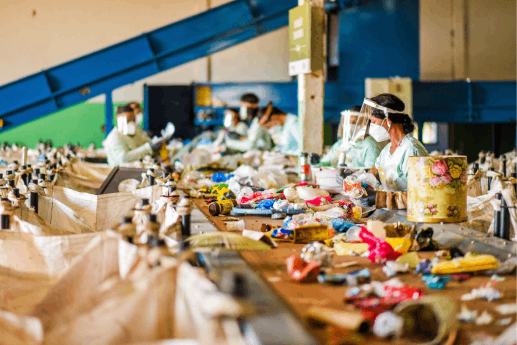All five dimensions must be addressed simultaneously during each maturity stage. The optimal combination of actions, investments, and policies defines the enabling policy framework for each specific maturity category.
These categories are the following:
Category 1 – Undeveloped Systems consists of countries with no or very basic waste management infrastructure with a plastic recycling rate of up to 5 per cent. Examples of countries include Kenya, Iraq and Congo.
Category 2 – Incipient Systems includes countries with basic waste regulations but limited collection and end-of-life treatment infrastructure. These countries have plastic recycling rates of up to 10 per cent. Examples of countries include Indonesia, Egypt and Saudi Arabia.
Category 3 – Developing Systems refers to countries with functional waste management systems. However, collection, sorting, incineration, and recycling are developed only to the extent they are justified by intrinsic economic value, without additional policy levers that drive recycling rates beyond 15 per cent. Examples of countries include China, Mexico and Australia.
Category 4 – Functional, Largely Unregulated Systems comprises countries that typically have recycling rates approaching 25 per cent motivated by some regulatory pressure. Examples of countries include the UK, India and Turkey.
Category 5 – Advanced Systems with Challenges encompasses countries that can achieve plastic recycling rates of up to 40 per cent, although they may still face challenges in specific segments in the value chain. Examples of countries include Japan, Italy and France.
Category 6 – Developed Performing Systems is the most advanced. Countries in this group achieve recycling rates of more than 40 per cent and demonstrate global best practice that can serve as beacons for other nations. Examples of countries include Germany, Belgium and the Netherlands.
According to the study, Extended Producer Responsibility (EPR) stands out as one the most effective policy instruments for increasing recycling rates overall, particularly in Category 3, 4, and 5 countries. Under EPR, the responsibility for achieving certain recycling rates lies with waste generators; the implementation of such a system therefore requires an alignment across the entire value chain – EPR enforces shared responsibility across the plastic value chain, including brands and retailers as well as post-use treatment. Money generated from EPR fees is typically directed towards improving waste management and recycling solutions, ideally harmonised across local geographies to maximise effectiveness. As the maturity of waste management in a country improves, mandatory and eventually eco-modulated EPR schemes should replace voluntary commitments.
The most advanced countries, such as those in categories 5 and 6 can benefit from laying out policy roadmaps with holistic objectives for the circularity of all waste types. They have the capacity and resources required to drive innovation such as enabling the highly granular sorting and traceability of plastic waste to efficiently supply the recycling economy. In these markets, EPR schemes should incentivise adoption of design-for-circularity principles, for example through eco-modulated fees.
The study found that, while more than 60 per cent of all countries recycle less than 8 per cent of plastic waste generated, it follows that category 1 and 2 countries have the biggest opportunity to end plastic waste leakage into the environment. Here, the informal “waste picker” sector plays a key role in waste management in these geographies, and should be acknowledged and supported, ensuring their inclusion when planning for the evolution of a country’s waste management system. Effective policy levers for category 1 and 2 countries include developing waste management legislation, building institutional capacity, and establishing financial obligations from brand owners and waste generators.
The study clearly showed the diversity in both the level of development of waste management systems around the world and the technical capabilities of the different countries. Proposed policy and infrastructure priorities need to reflect these considerations alongside the availability of resources to deliver systems change.
Jacob Duer, president and CEO at the Alliance said, “Over the past decade, plastic consumption has steadily increased in tandem with global economic growth. Yet 70 per cent of all plastic waste remains uncollected, leaks into the environment, ends up in landfill, or is incinerated. Every nation has the opportunity to improve by setting priorities and developing pragmatic solutions that are appropriate for their current state of maturity in managing waste, guided by the vision of a circular economy.”
“The United Nations Environment Assembly’s resolution to develop an international legally binding instrument on plastic pollution can be a major contributor to setting these priorities. As the Alliance’s waste management maturity framework highlights, there is no one-size-fits-all solution, but there are policy levers available at all levels which will drive rapid progress towards a sustainable transition to plastic circularity.”
Source: sustainableplastics.com








